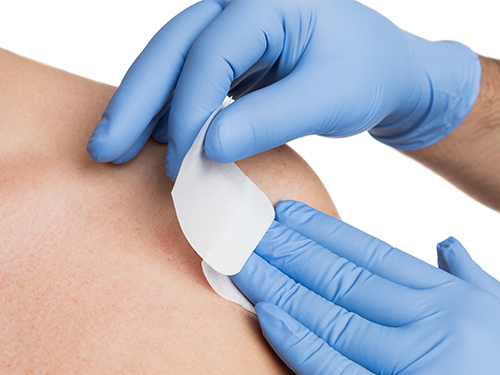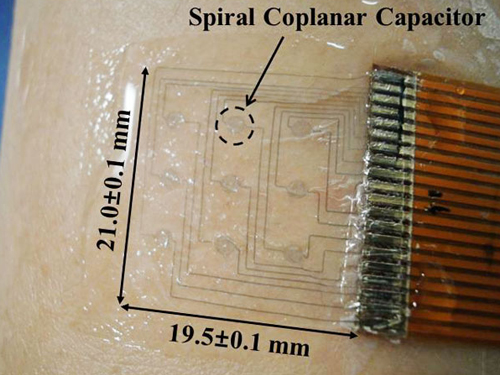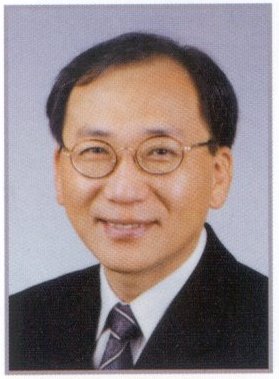NanoSentuating+Systems+lab
-
 Attachable Skin Monitors that Wick the Sweat Away
- A silicone membrane for wearable devices is more comfortable and breathable thanks to better-sized pores made with the help of citric acid crystals. -
A new preparation technique fabricates thin, silicone-based patches that rapidly wick water away from the skin. The technique could reduce the redness and itching caused by wearable biosensors that trap sweat beneath them. The technique was developed by bioengineer and professor Young-Ho Cho and his colleagues at KAIST and reported in the journal Scientific Reports last month.
“Wearable bioelectronics are becoming more attractive for the day-to-day monitoring of biological compounds found in sweat, like hormones or glucose, as well as body temperature, heart rate, and energy expenditure,” Professor Cho explained. “But currently available materials can cause skin irritation, so scientists are looking for ways to improve them,” he added.
Attachable biosensors often use a silicone-based compound called polydimethylsiloxane (PDMS), as it has a relatively high water vapour transmission rate compared to other materials. Still, this rate is only two-thirds that of skin’s water evaporation rate, meaning sweat still gets trapped underneath it.
Current fabrication approaches mix PDMS with beads or solutes, such as sugars or salts, and then remove them to leave pores in their place. Another technique uses gas to form pores in the material. Each technique has its disadvantages, from being expensive and complex to leaving pores of different sizes.
A team of researchers led by Professor Cho from the KAIST Department of Bio and Brain Engineering was able to form small, uniform pores by crystallizing citric acid in PDMS and then removing the crystals using ethanol. The approach is significantly cheaper than using beads, and leads to 93.2% smaller and 425% more uniformly-sized pores compared to using sugar. Importantly, the membrane transmits water vapour 2.2 times faster than human skin.
The team tested their membrane on human skin for seven days and found that it caused only minor redness and no itching, whereas a non-porous PDMS membrane did.
Professor Cho said, “Our method could be used to fabricate porous PDMS membranes for skin-attachable devices used for daily monitoring of physiological signals.”
“We next plan to modify our membrane so it can be more readily attached to and removed from skin,” he added.
This work was supported by the Ministry of Trade, Industry and Energy (MOTIE) of Korea under the Alchemist Project.
Image description:
Smaller, more uniformly-sized pores are made in the PDMS membrane by mixing PDMS, toluene, citric acid, and ethanol. Toluene dilutes PDMS so it can easily mix with the other two constituents. Toluene and ethanol are then evaporated, which causes the citric acid to crystallize within the PDMS material. The mixture is placed in a mould where it solidifies into a thin film. The crystals are then removed using ethanol, leaving pores in their place.
Image credit:
Professor Young-Ho Cho, KAIST
Image usage restrictions:
News organizations may use or redistribute this image, with proper attribution, as part of news coverage of this paper only.
Publication:
Yoon, S, et al. (2021) Wearable porous PDMS layer of high moisture permeability for skin trouble reduction. Scientific Reports 11, Article No. 938. Available online at https://doi.org/10.1038/s41598-020-78580-z
Profile:
Young-Ho Cho, Ph.D
Professor
mems@kaist.ac.kr
https://mems.kaist.ac.kr
NanoSentuating Systems Laboratory
Department of Bio and Brain Engineering
https://kaist.ac.kr
Korea Advanced Institute of Science and Technology (KAIST)
Daejeon, Republic of Korea
(END)
2021.02.22 View 14973
Attachable Skin Monitors that Wick the Sweat Away
- A silicone membrane for wearable devices is more comfortable and breathable thanks to better-sized pores made with the help of citric acid crystals. -
A new preparation technique fabricates thin, silicone-based patches that rapidly wick water away from the skin. The technique could reduce the redness and itching caused by wearable biosensors that trap sweat beneath them. The technique was developed by bioengineer and professor Young-Ho Cho and his colleagues at KAIST and reported in the journal Scientific Reports last month.
“Wearable bioelectronics are becoming more attractive for the day-to-day monitoring of biological compounds found in sweat, like hormones or glucose, as well as body temperature, heart rate, and energy expenditure,” Professor Cho explained. “But currently available materials can cause skin irritation, so scientists are looking for ways to improve them,” he added.
Attachable biosensors often use a silicone-based compound called polydimethylsiloxane (PDMS), as it has a relatively high water vapour transmission rate compared to other materials. Still, this rate is only two-thirds that of skin’s water evaporation rate, meaning sweat still gets trapped underneath it.
Current fabrication approaches mix PDMS with beads or solutes, such as sugars or salts, and then remove them to leave pores in their place. Another technique uses gas to form pores in the material. Each technique has its disadvantages, from being expensive and complex to leaving pores of different sizes.
A team of researchers led by Professor Cho from the KAIST Department of Bio and Brain Engineering was able to form small, uniform pores by crystallizing citric acid in PDMS and then removing the crystals using ethanol. The approach is significantly cheaper than using beads, and leads to 93.2% smaller and 425% more uniformly-sized pores compared to using sugar. Importantly, the membrane transmits water vapour 2.2 times faster than human skin.
The team tested their membrane on human skin for seven days and found that it caused only minor redness and no itching, whereas a non-porous PDMS membrane did.
Professor Cho said, “Our method could be used to fabricate porous PDMS membranes for skin-attachable devices used for daily monitoring of physiological signals.”
“We next plan to modify our membrane so it can be more readily attached to and removed from skin,” he added.
This work was supported by the Ministry of Trade, Industry and Energy (MOTIE) of Korea under the Alchemist Project.
Image description:
Smaller, more uniformly-sized pores are made in the PDMS membrane by mixing PDMS, toluene, citric acid, and ethanol. Toluene dilutes PDMS so it can easily mix with the other two constituents. Toluene and ethanol are then evaporated, which causes the citric acid to crystallize within the PDMS material. The mixture is placed in a mould where it solidifies into a thin film. The crystals are then removed using ethanol, leaving pores in their place.
Image credit:
Professor Young-Ho Cho, KAIST
Image usage restrictions:
News organizations may use or redistribute this image, with proper attribution, as part of news coverage of this paper only.
Publication:
Yoon, S, et al. (2021) Wearable porous PDMS layer of high moisture permeability for skin trouble reduction. Scientific Reports 11, Article No. 938. Available online at https://doi.org/10.1038/s41598-020-78580-z
Profile:
Young-Ho Cho, Ph.D
Professor
mems@kaist.ac.kr
https://mems.kaist.ac.kr
NanoSentuating Systems Laboratory
Department of Bio and Brain Engineering
https://kaist.ac.kr
Korea Advanced Institute of Science and Technology (KAIST)
Daejeon, Republic of Korea
(END)
2021.02.22 View 14973 -
 Newsweek: The Goosebump Sensor That Knows How You Feel
Newsweek covered the introduction of the goosebump sensor invented by Professor Young-Ho Cho of the Department of Bio and Brain Engineering at KAIST in an article dated July 27, 2014.
The article entitled “The Goosebump Sensor That Knows How You Feel” explains how the sensor works and reports on the current research and development trends in emotion-sensing technology.
Professor Cho’s research paper was originally published in the journal Applied Physics Letters on June 24, 2014, titled “A Flexible Skin Piloerection Monitoring Sensor."
Newsweek, July 27, 2014
“The Goosebump Sensor That Knows How You Feel”
http://www.newsweek.com/goosebump-sensor-knows-how-you-feel-260689
2014.07.28 View 9283
Newsweek: The Goosebump Sensor That Knows How You Feel
Newsweek covered the introduction of the goosebump sensor invented by Professor Young-Ho Cho of the Department of Bio and Brain Engineering at KAIST in an article dated July 27, 2014.
The article entitled “The Goosebump Sensor That Knows How You Feel” explains how the sensor works and reports on the current research and development trends in emotion-sensing technology.
Professor Cho’s research paper was originally published in the journal Applied Physics Letters on June 24, 2014, titled “A Flexible Skin Piloerection Monitoring Sensor."
Newsweek, July 27, 2014
“The Goosebump Sensor That Knows How You Feel”
http://www.newsweek.com/goosebump-sensor-knows-how-you-feel-260689
2014.07.28 View 9283 -
 World Micromachine Summit to Open in Daejeon
The 2008 World Micromachine Summit will be held at Hotel Riviera in Daejeon for a four-day run from April 30, drawing worldwide industrial and academic leaders in the micro-nano-technology (MNT).
Organizers say that 76 delegates and 56 observers from 19 countries and regions will take part in this year"s Micromachine Summit. Prof. Cho Young-ho of the Department of Bio & Brain Engineering of KAIST will play host to the annual event.
Participants will discuss the progress of micro-nano-technology in each country and region development of national policies in this area. The Summit was first organized in 1995 by the Micromachine Center of Japan with representatives from 10 countries participating. They were Australia, Canada, Germany, Italy, Japan, the Netherlands, Switzerland, the United Kingdom, and the United States.
Korea was first invited to the conference in 1999. Since then, Korea has played an active role in promoting technological exchanges among nations and has conducted presentations and discussions on major technological breakthroughs.
During the four-day run, each delegation will outline their country"s policies and strategies and present local features on focused areas including this year"s main theme, "Micromachine towards Technology Convergence Era."
The gathering will offer a valuable opportunity for the participants to exchange and collect information on the current state of the MNT, as well as providing a forum for worldwide networking of leaders in the area.
2008.04.29 View 15500
World Micromachine Summit to Open in Daejeon
The 2008 World Micromachine Summit will be held at Hotel Riviera in Daejeon for a four-day run from April 30, drawing worldwide industrial and academic leaders in the micro-nano-technology (MNT).
Organizers say that 76 delegates and 56 observers from 19 countries and regions will take part in this year"s Micromachine Summit. Prof. Cho Young-ho of the Department of Bio & Brain Engineering of KAIST will play host to the annual event.
Participants will discuss the progress of micro-nano-technology in each country and region development of national policies in this area. The Summit was first organized in 1995 by the Micromachine Center of Japan with representatives from 10 countries participating. They were Australia, Canada, Germany, Italy, Japan, the Netherlands, Switzerland, the United Kingdom, and the United States.
Korea was first invited to the conference in 1999. Since then, Korea has played an active role in promoting technological exchanges among nations and has conducted presentations and discussions on major technological breakthroughs.
During the four-day run, each delegation will outline their country"s policies and strategies and present local features on focused areas including this year"s main theme, "Micromachine towards Technology Convergence Era."
The gathering will offer a valuable opportunity for the participants to exchange and collect information on the current state of the MNT, as well as providing a forum for worldwide networking of leaders in the area.
2008.04.29 View 15500 -
 2008 Commencement Ceremony Held
The 2008 KAIST Commencement Ceremony was held on Feb. 29 at the KAIST Amphitheater in the presence of KAIST President Nam Pyo Suh, U.S. Ambassador to Korea Alexander Vershbow, alumni representatives and parents.
Other dignitaries on hand included National Assemblymen Sang-Kee Suh, Chang-Sun Hong and Sang-Min Lee; and Daejoen City Major Sung-Hyo Park.
President Suh and Vice President Soon-Heung Chang presented degrees to each of the 1,321 graduates (200 doctors, 725 masters and 396 bachelors) instead of just to representatives. Since its inception in 1971, KAIST has produced 7,067 Ph.D. graduates, 18,636 master"s degree holders and 8,998 bachelor"s degree holders. This year, 40 percent of the Ph.D. graduates, 79, were in their twenties upon graduation.
President Suh called on the graduates to return the favor they received from society by making their share of contributions to humanity. "You were chosen to be students of this unique university because the Korean people -- not only KAIST professors and staff, but also ordinary taxpayers -- believe that outstanding young people like you can change the world in which we live for the better. Now it is time for you to pay back their support," he said.
Notable graduates of this year include So-Yeon Yi, 29, the first Korean female astronaut candidate, who earned her doctorate degree in bio and brain engineering. She was granted a special award in recognition of her role in advancing space science in Korea but she could not attend the graduation ceremony due to her training schedule in Russia which will continue until April.
Eun-Gyu Oh, 26, was the youngest doctorate recipient in the ceremony and Won Hye-jeong, 21, recorded the top undergraduate GPA with a score of 4.20 over 4.3. Civil and environmental engineering major Seung-Hee Park, 28, published a total of eight papers in major international journals while attending KAIST and two more papers are currently under review.
So-Yeon Yi said: ``I frequently stayed up all night to research and write the paper. It was tough experience for me. Thanks to ceaseless support from professors and colleagues, however, I was able to complete the task,"" she said. ``I have done my best in studying, exercising and so on. I"m sure that my active, participatory attitude brought about this honorable moment.""
She is now training at Gagarin Cosmonaut Training Center near Moscow as a replacement astronaut in case Koh San, 31, who is to be the first Korean astronaut, is unable to go into orbit.
Koh and Yi were selected from more than 36,000 applicants last year. Koh was finally picked as the primary candidate last September. The two are serving as space ambassadors appointed by the Ministry of Science & Technology.
2008.03.09 View 17527
2008 Commencement Ceremony Held
The 2008 KAIST Commencement Ceremony was held on Feb. 29 at the KAIST Amphitheater in the presence of KAIST President Nam Pyo Suh, U.S. Ambassador to Korea Alexander Vershbow, alumni representatives and parents.
Other dignitaries on hand included National Assemblymen Sang-Kee Suh, Chang-Sun Hong and Sang-Min Lee; and Daejoen City Major Sung-Hyo Park.
President Suh and Vice President Soon-Heung Chang presented degrees to each of the 1,321 graduates (200 doctors, 725 masters and 396 bachelors) instead of just to representatives. Since its inception in 1971, KAIST has produced 7,067 Ph.D. graduates, 18,636 master"s degree holders and 8,998 bachelor"s degree holders. This year, 40 percent of the Ph.D. graduates, 79, were in their twenties upon graduation.
President Suh called on the graduates to return the favor they received from society by making their share of contributions to humanity. "You were chosen to be students of this unique university because the Korean people -- not only KAIST professors and staff, but also ordinary taxpayers -- believe that outstanding young people like you can change the world in which we live for the better. Now it is time for you to pay back their support," he said.
Notable graduates of this year include So-Yeon Yi, 29, the first Korean female astronaut candidate, who earned her doctorate degree in bio and brain engineering. She was granted a special award in recognition of her role in advancing space science in Korea but she could not attend the graduation ceremony due to her training schedule in Russia which will continue until April.
Eun-Gyu Oh, 26, was the youngest doctorate recipient in the ceremony and Won Hye-jeong, 21, recorded the top undergraduate GPA with a score of 4.20 over 4.3. Civil and environmental engineering major Seung-Hee Park, 28, published a total of eight papers in major international journals while attending KAIST and two more papers are currently under review.
So-Yeon Yi said: ``I frequently stayed up all night to research and write the paper. It was tough experience for me. Thanks to ceaseless support from professors and colleagues, however, I was able to complete the task,"" she said. ``I have done my best in studying, exercising and so on. I"m sure that my active, participatory attitude brought about this honorable moment.""
She is now training at Gagarin Cosmonaut Training Center near Moscow as a replacement astronaut in case Koh San, 31, who is to be the first Korean astronaut, is unable to go into orbit.
Koh and Yi were selected from more than 36,000 applicants last year. Koh was finally picked as the primary candidate last September. The two are serving as space ambassadors appointed by the Ministry of Science & Technology.
2008.03.09 View 17527